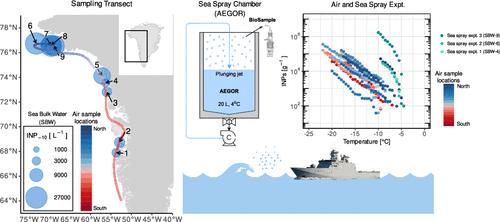Atmospheric Biogenic Ice-Nucleating Particles Link to Microbial Communities in the Arctic Marine Environment in Western Greenland
IF 11.3
1区 环境科学与生态学
Q1 ENGINEERING, ENVIRONMENTAL
引用次数: 0
Abstract
Biogenic ice-nucleating particles (INPs) can significantly impact mixed-phase clouds by enhancing precipitation and reducing albedo. As Arctic sea ice diminishes, the exposure of open ocean may increase aerosolization rates of marine bioaerosols and INPs. We investigated INP concentrations and microbial communities in ambient marine air, sea bulk water (SBW), and sea surface microlayer (SML) along a transect from the Davis Strait to Baffin Bay. INP concentrations in SBW increased with latitude, regardless of the extent of terrestrial freshwater input. We further identified correlations between INP levels and abundances of specific microbial taxa, including Formosa, Lewinella, Micromonas, and Dino-Group-I-Clade-5, suggesting potential ice nucleation activity of these taxa. Air samples exhibited distinct microbiomes compared to seawater, indicating terrestrial contributions, but at the highest observed wind speeds (7–8 m/s), substantial contributions of the seawater microbiome were detected in the air. Elevated atmospheric INP concentrations at higher latitudes correlated with seawater INP levels, which was supported by laboratory sea spray experiments showing that INPs in SBW influenced aerosol INP levels. Our findings highlight the Arctic Ocean as a significant source of biogenic atmospheric INPs and enhance our understanding of marine microbes as contributors to biogenic INPs. By identification of potential ice nucleation active microbial taxa and examination of aerosolization processes, this study provides a framework for future research on Arctic marine-derived INPs and their atmospheric impact.

格陵兰岛西部北极海洋环境中大气生冰成核粒子与微生物群落的联系
生物冰核粒子(INPs)通过增强降水和降低反照率对混合相云产生显著影响。随着北极海冰的减少,开放海洋的暴露可能会增加海洋生物气溶胶和INPs的雾化速率。研究了从戴维斯海峡到巴芬湾的样带海洋空气、海水散水(SBW)和海面微层(SML)中INP浓度和微生物群落。无论陆地淡水输入的程度如何,西南偏南地区的INP浓度随纬度增加而增加。我们进一步确定了INP水平与特定微生物类群丰度的相关性,包括Formosa, Lewinella, Micromonas和Dino-Group-I-Clade-5,表明这些类群可能具有冰核活性。与海水样品相比,空气样品显示出不同的微生物组,表明陆地贡献,但在观测到的最高风速(7-8 m/s)下,在空气中检测到大量的海水微生物组贡献。高纬度地区大气中INP浓度升高与海水中INP水平相关,实验室海雾实验支持了这一点,表明SBW中的INP影响气溶胶中INP水平。我们的发现强调了北冰洋是生物源性大气INPs的重要来源,并增强了我们对海洋微生物作为生物源性INPs贡献者的理解。通过对潜在冰核活性微生物类群的识别和对气溶胶过程的研究,本研究为未来北极海洋源INPs及其大气影响的研究提供了框架。
本文章由计算机程序翻译,如有差异,请以英文原文为准。
求助全文
约1分钟内获得全文
求助全文
来源期刊

环境科学与技术
环境科学-工程:环境
CiteScore
17.50
自引率
9.60%
发文量
12359
审稿时长
2.8 months
期刊介绍:
Environmental Science & Technology (ES&T) is a co-sponsored academic and technical magazine by the Hubei Provincial Environmental Protection Bureau and the Hubei Provincial Academy of Environmental Sciences.
Environmental Science & Technology (ES&T) holds the status of Chinese core journals, scientific papers source journals of China, Chinese Science Citation Database source journals, and Chinese Academic Journal Comprehensive Evaluation Database source journals. This publication focuses on the academic field of environmental protection, featuring articles related to environmental protection and technical advancements.
 求助内容:
求助内容: 应助结果提醒方式:
应助结果提醒方式:


